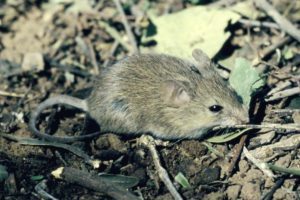

All human viruses have their origin in a virus that crossed from a different animal species. The encounters that lead to these spillovers are driven by explosive human population growth and incredible change occurring in all ecosystems brought about by human occupation of almost every corner of the planet. The extent to which land-use change contributes to zoonotic diseases has always been suspected and was recently established by a global study of the effect of such changes on local zoonotic host communities.
One of my favorite stories about how land use changes drive zoonotic emergence is about Argentine hemorrhagic fever. Between the two world wars, the Argentine pampa was converted to fields for the massive growth of maize by eliminating weeds by the use of herbicides. The maize grew, but in its shadow a new shade-tolerant weed flourished. This weed led to the emergence of a new dominant mouse, Calomys musculinus (pictured; image credit). A novel human hemorrhagic fever was first described in this area in 1953, and the causative agent, Junin virus, was isolated from the new mouse.
To examine the global importance of such land use changes in the exposure of humans to new zoonotic diseases, a global database of 6,801 ecological assemblages was examined. The database compiles >3.2 million species records from 666 published studies in which biodiversity across land use was sampled. Records of 376 host species in 6,801 survey sites were identified across 6 continents.
The analysis revealed that known wildlife hosts of pathogens shared with humans make up a greater proportion of local species richness (18€“72% higher) and total abundance (21€“144% higher) in sites under extensive human use (secondary, agricultural and urban ecosystems) compared with nearby undisturbed habitats. The magnitude of this effect varies according to the species, but it is the strongest for rodent, bat and passerine bird zoonotic host species. These taxa are important as zoonotic reservoirs. In addition, mammals that harbor more pathogens are more likely to be present in human-managed ecosystems.
These findings indicate that that anthropogenic global land use changes are establishing interfaces between people, livestock and wildlife reservoirs of zoonotic disease that will increase the chances of future outbreaks and pandemics.
Some readers might be asking, how did land use change lead to emergence of SARS-CoV-2? We know that the virus emerged from a bat reservoir in rural China, where farming has intensified in recent decades. Such activities place farmers in contact with wildlife, allowing regular spillover of viruses. Eventually these events will hit the jackpot – a randomly emerged virus that just so happens to be able to efficiently infect humans.
A potential solution to this problem? There are many reasons for anthropogenic land use modification by humans, but a major one is for farming. Move this activity indoors, to Vertical Farms.

Pingback: Pandemics and anthropogenic environmental change - Virology Hub
Presumably, with unfettered human pillaging of what is left of ‘the wild’, this acquiring of new diseases from other species can only continue for a limited time, until we have nothing left to exterminate. This must surely happen sooner, rather than later. :/
Thank you for your very interesting post. You write that “all human viruses have their origin in a virus that crossed from a different animal species”. Is there evidence of viruses that crossed from our species into different animal species, giving origin to diseases previously unknown in such animals?
Good article. There is a Chinese translation for this article: æ–°å† ç—…æ¯’çš„å¤§æµè¡ŒæºäºŽäººç±»å¯¹çŽ¯å¢ƒçš„ç ´å? http://blog.sciencenet.cn/blog-347754-1247620.html 2020-08-24
Pingback: Ma nella sua ombra prosperava un’erbaccia | Irresistibili
Pingback: Fa fare tombola a un virus | Irresistibili